When and How to Introduce a Pacifier to Your Newborn
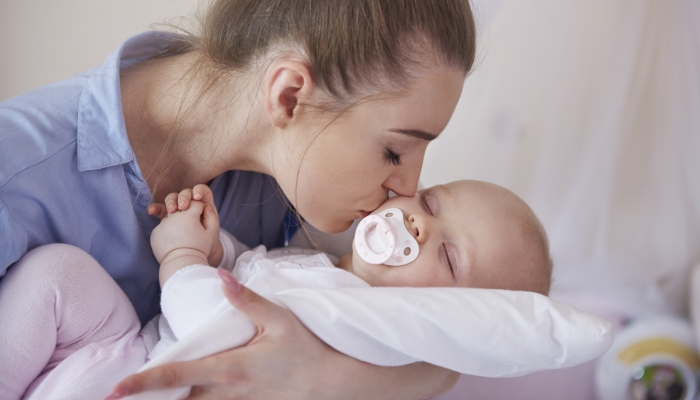
- When a baby’s sucking reflex is activated, it lowers the baby’s heart rate, lowers blood pressure, and can even help them cope with pain.
- If you’re bottle-feeding your little one, you can introduce a pacifier right away.
- In order to avoid confusion, only introduce a pacifier to a breastfed baby after a few weeks of successful breastfeeding.
What did parents do before pacifiers? If you’ve ever had a crying baby on an airplane or a screaming infant in a waiting room, you’ve probably reached for this popular baby item. They are truly a sanity saver when you’ve tried everything to soothe your baby.
While some parents swear by pacifier use, others complain that their baby won’t take a pacifier despite their efforts. Those parents might be desperate to find ways to soothe their little ones.
But what’s the best way to introduce your baby to a pacifier? And how soon is too soon?
If you’re looking to introduce a pacifier to your baby, these tips will help! We’ve outlined all the information you need on how and when to introduce a pacifier.
Do Babies Need Pacifiers?
When you have a baby, one of the first soothing tools the nurses offer your baby is a pacifier. Pacifiers have been used for over 100 years by parents everywhere. But are they really necessary?
Here are some of the many pros of using pacifiers:
Calms Baby Quickly
One primary reason that parents turn to pacifiers is to help quiet their fussy babies. But you might wonder why this works. Long before a baby enters the world, they are already using their sucking skills to self-soothe and prepare for life outside the womb.
Their little brains already know this skill is necessary for survival. However, this skill isn’t just used for nutrition purposes. When a baby’s sucking reflex is activated, it lowers the baby’s heart rate, lowers blood pressure, and can even help them cope with pain.
Can Be Taken Away
Unlike finger or thumb sucking, a pacifier can be taken away when you decide it’s the right time for pacifier weaning. Many parents of thumb suckers struggle to get their children to break the bad habit. Though taking away the paci might be hard, it’s completely in the hands of the parent.
This is good news, as prolonged pacifier use can cause dental issues.
Reduces the Risk of SIDS
This benefit of pacifier use is a bit of a mystery. Researchers have yet to discover why this happens. Yet pacifier use has been proven to reduce the risk of sudden infant death syndrome over and over again.
What’s interesting is that the baby doesn’t even have to keep the pacifier in their mouth all night for it to lower their risk. This means parents don’t have to frantically check their baby or wonder how to keep a pacifier in baby’s mouth through the night. Just giving a pacifier to your baby for naps and nighttime sleep will help them continue to breathe through the night.
Helps Baby Learn to Self-Soothe
In order for a baby to establish healthy sleep habits, they’ll need to learn to self-soothe. When babies fall asleep with help, parents often wonder how to get their baby to sleep without being held, breastfed, or rocked. Offering your baby a pacifier for sleep instead of something that requires your presence will help them learn to self-soothe.
Reduces Gas Pain
Gas often causes a lot of pain for babies. Many products exist that promise to bring an end to gas pain. Pacifier use might be one of these.
When a baby sucks on a pacifier, it releases endorphins that help reduce pain levels. Pacifiers don’t limit the amount of gas in a baby’s belly. However, it might be a good option to help a baby cope.
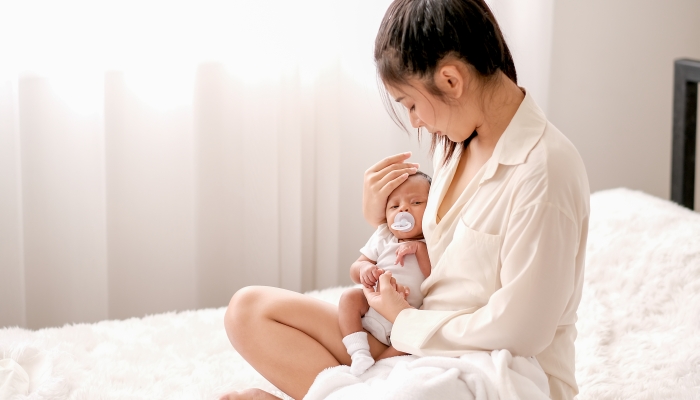
Does Using a Pacifier Have Risks?
Pacifier use doesn’t come without risks. There are certain risks that might be more of an inconvenience than others. However, it’s important for parents to understand that the benefit of reducing SIDS risks still outweighs the downsides of pacifier use.
Here are a few reasons why parents might choose to avoid pacifier use:
Increases Risk of Ear Infections
One drawback to using a pacifier is that it seems to increase the risk of infections in the ear. A 2002 review found that babies who used a pacifier had up to 3 times the risk of ear infections than babies who did not use a pacifier. However, it was also found that the risk increased with an increase in pacifier use.
This risk may increase with the baby’s age. Babies under 6 months of age have lower cases of ear infections, to begin with. This might be the best time to use a pacifier without major risks of ear infections.
Baby Might Not Sleep Soundly
When a little one learns to fall asleep with a pacifier, they become reliant on sucking to fall asleep and stay asleep. Some infants might even wake in the night when their pacifier falls out. Parents often put several pacifiers in their child’s crib once they’re old enough to crawl and reach for their paci.
Can Become a Bad Habit
Since parents often turn to pacifiers to quiet their infants, it can easily become a hard habit to break. Parents might even turn to pacifiers when their child is signaling they’re in pain or hungry. Instead, you should always check your baby for a dirty diaper, rash, hunger, etc. before reaching for your baby’s pacifier.
Pacifiers can also become a hard habit to break in toddlers. This is especially true for a strong-willed toddler. Thankfully there are a lot of parents who have broken the pacifier habit and have helpful parenting tips to share.
Might Cause Dental Issues
The American Dental Association has found that children who use pacifiers past the age of 4 are at a greater risk for damage to their teeth, soft palate, and jaw. The American Academy of Pediatric Dentistry recommends parents wean their children from pacifiers by 18 months to avoid developing pacifier teeth.
Research shows that daily, prolonged use of pacifiers may be connected with speech problems. However, the data is limited and should not be used to discredit pacifier use.
What Is the Best Type of Pacifier for Newborns?
Dentists often note that orthodontic pacifiers are the best pacifiers to use for newborns and babies. Orthodontic pacifiers are designed to cause the least amount of damage to a baby’s developing mouth. Their design supports a baby’s palate and creates less abnormal pressure on their teeth and jaw than a regular pacifier.
The best pacifier for your little one is also the pacifier that fits their mouth. Pacifiers come in different sizes, and it’s important to choose the right size. This will ensure it correctly fits in the mouth and doesn’t cause damage.
When to Introduce a Pacifier to Your Newborn
The right time to introduce a pacifier to your newborn will largely depend on how you will be feeding your little one. The recommendations are different for breastfeeding vs formula feeding.
When is the right time to introduce a pacifier to a bottle-fed baby?
If you’re bottle-feeding your little one, you can introduce pacifiers right away. A bottle nipple and a pacifier are similar in structure. Most babies will be able to transfer back and forth without any confusion.
When is the right time to introduce a pacifier to a breastfed baby?
Breastfed babies shouldn’t be introduced to pacifiers right away. In the early weeks of feeding, a nursing infant can develop nipple confusion. Nipple confusion is when a baby becomes frustrated and has difficulty switching from bottle to breast.
Artificial nipples used in pacifiers and bottles are designed to mimic the breast and nipple. Some breastfeeding mothers find that their child prefers one over the other. This can discourage a baby from breastfeeding and cause stress for the mother.
In order to avoid confusion, only introduce a pacifier after a few weeks of successful breastfeeding. Ensure that you have a good milk supply and that your child is comfortable breastfeeding. Then you can try offering pacifiers in addition to nursing.
The risk of nipple confusion is also lower when breastfeeding term infants. If your little one was born early, you might need to wait a little longer. Don’t try and rush the process or you might end with more trouble than benefit from pacifiers.
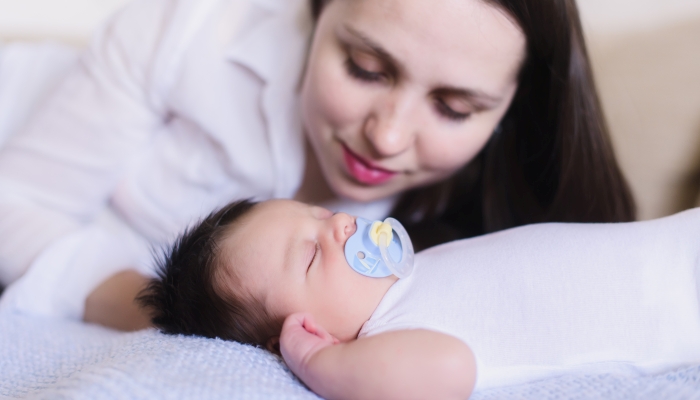
How to Introduce a Pacifier to Your Newborn
To introduce your child to a pacifier, start by placing the pacifier on your baby’s lips. Try and move the pacifier over your baby’s mouth until they act interested and open their mouth wide. If your baby forces the pacifier back out, try again later.
You shouldn’t force a baby to take a pacifier, as this can cause frustration. You should also avoid using any sweet substances on the nipple to get the baby to take the paci. Using sugary substances can lead to tooth decay.
Safety Tips When Giving a Pacifier to Your Newborn
When using a pacifier, be sure to follow these pacifier safety tips to avoid harm:
- Never use a bottle nipple in place of a pacifier.
- Parents should sterilize pacifiers often by boiling the pacifier in water for 5 minutes.
- Clean the pacifier daily with soap and hot water to avoid bacteria buildup.
- Check your baby’s pacifier daily for cracks or signs of wear. A broken pacifier can be a choking hazard. You should discard worn pacifiers immediately.
- Be sure the pacifier’s shield is at least 1½ inches wide so your baby can’t put the entire pacifier in their mouth. The shield should also have ventilation holes to prevent suffocation.
Can a baby sleep overnight with a pacifier?
Yes, it is safe for a baby to sleep overnight with a pacifier. In fact, many doctors recommend nighttime pacifier use to reduce the risk of SIDS. A baby’s bed should be free of extra blankets, stuffed animals, or anything that would wrap around a baby’s neck or cover their face.
FAQs
How will you know whether the baby is hungry or just wants a pacifier?
Babies have hunger cues that parents can learn to identify. These often include:
- Crying
- Licking the lips
- Sucking on their fist
- Rooting (opening the mouth and turning the neck to search for a food source)
If you give a hungry baby a pacifier, they will likely take it, but won’t be satisfied long. If you offer the breast or bottle and they eat normally, they were probably hungry.
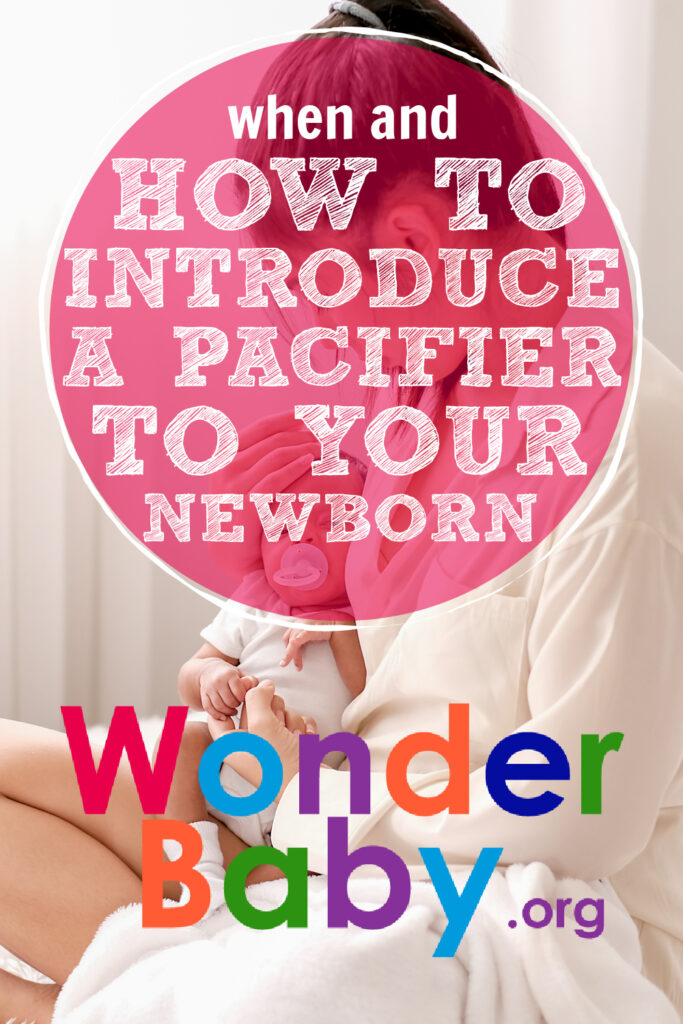
The information WonderBaby provides is not intended to be, and does not constitute, medical or other health advice or diagnosis and should not be used as such. Always consult with a qualified medical professional about your specific circumstances.
Related Posts
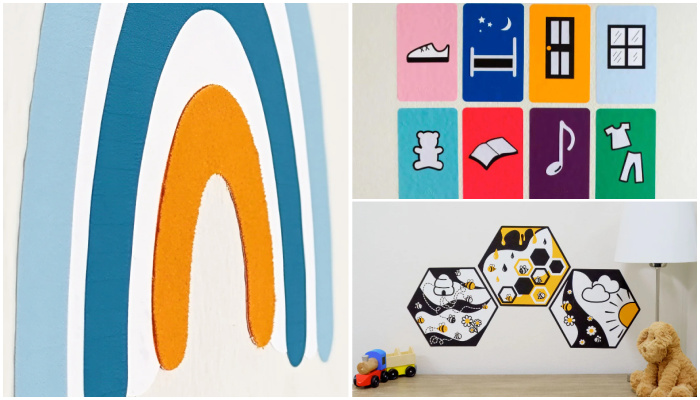
Parenting
Sensory Wall Art: 5 Tips to Create a Room Your Blind or Low-Vision Child Will Love
Even if your child can’t see their surroundings, personalizing and decorating their room with thoughtful, sensory-friendly design can make a big difference in their confidence, independence, and joy.
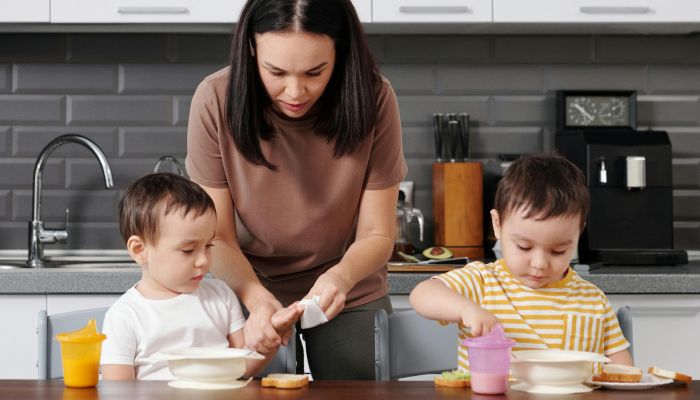
Parenting
4 Tips to Manage Twins Alone as a Single Parent
Taking care of twins alone as a single parent can feel overwhelming. Learn practical ways to help lighten the load.

Parenting
How to Manage Twin Escalation Syndrome
Discover effective strategies for managing twin escalation syndrome, including promoting individuality and fostering positive interactions.